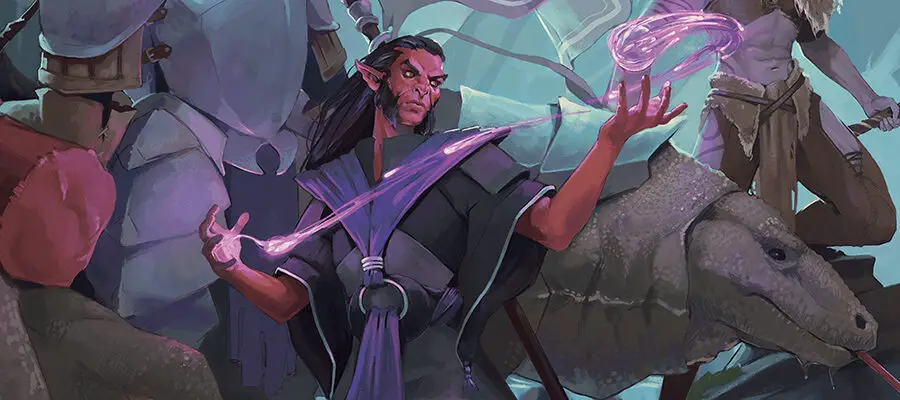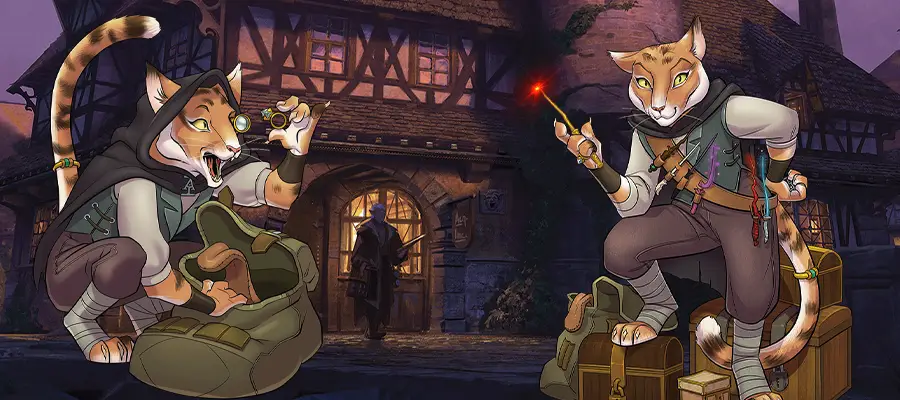This article’s featured image for D&D 5e Sorcerer Subclass Ratings Ranked Best to Worst is from Critical Role Presents: Call of the Netherdeep. This article contains affiliate links that add gold to our coffers.
This article is meant to be fun for seasoned players to compare their favorites. It can also help new players narrow their choices to maximize their fun. Which Sorcerer subclasses are the best in D&D 5e?
Premise and Rating System
I’m rating each subclass based on the game overall for Sorcerers only, so I’m not comparing a Sorcerer subclass to a Fighter subclass. That wouldn’t feel fair. I also rate each subclass based on five criteria:
- High-level Functionality: How well the subclass functions and keeps up with other options beyond level ten.
- Low-level Functionality: How well the subclass functions and keeps up with other options between levels one to nine. The subclass might be a strong multiclass dip option.
- Versatility & Fun: The subclass offers multiple ways to play it without making a player feel stuck. Features are enjoyable and cohesive.
- Design & Accessibility: I favor character options that are easy to understand and use. If they’re innovative and unique to other character options in the game, even better. A subclass that reinvents or reinvigorates neglected game mechanics receives top marks.
- Lore & Roleplaying: Subclasses that evoke fantastic stories, can be flavored in a variety of ways, and are easy to imagine conceptually.
This clearly isn’t a science, but it’s the system that works for me! It also helps me to be objective and not feel burdened by community perceptions.
Quick Poll: Favorite Sorcerer Subclasses from the 5e Community
Before or after you read through my Sorcerer subclass ratings, let us know which is your favorite! Voting will reveal the votes of others, too.
Skip to Your Favorite Sorcerer Subclass Rating
— Aberrant Mind
— Clockwork Soul
— Divine Soul
— Draconic Bloodline
— Shadow Magic
— Storm Sorcery
— Wild Magic
Aberrant Mind Sorcerer Subclass (TCoE)
Bonus cantrips: Mind Sliver
Bonus spells:
- Arms of Hadar, Dissonant Whispers
- Detect Thoughts, Calm Emotions
- Hunger of Hadar, Sending
- Evard’s Black Tentacles, Summon Aberration
- Telekinesis, Rary’s Telepathic Bond
Summary of subclass features: Psionic Spells expanded spells (see above) that can be swapped for divination and enchantment spells. Telepathy with creatures one-on-one. Casting Psionic Spells with Sorcery Points instead of spell slots and without verbal or somatic components. Alter your body with a transformation where you choose one trait per Sorcery Point spent, and the options include swimming/underwater breathing, flying, sliming, and seeing invisibility. Teleport while dealing damage to those you leave behind while moving them toward your previous location.
- High-level Functionality: ★★★★★
- Low-level Functionality: ★★★★
- Versatility & Fun: ★★★★★
- Design & Accessibility: ★★★★
- Lore & Roleplaying: ★★★★★
Flutes’ Evaluation (5/5):
This subclass is strong because of its expanded spell list alone. Beyond that, its features are strong and useful, making this Aberrant Mind Sorcerer subclass very strong. Psionic Sorcery is a fantastic Sorcerer feature that enables more Sorcery Points to be used on spell generation.
Aberrant Mind does well at all levels, though it has a slow start from levels 1-4. Telepathy isn’t a huge boon at low levels. Newer players may not see some of the value in the subclass, but those who play D&D enough will know its value to a Sorcerer.
Revelation in Flesh is extremely versatile and useful. Psychic Defense against psychic damage is fine, but its resistance is important against charm and fright. Warping Implosion is cool, though it’s not mind-blowing for level eighteen.
Overall, Aberrant Mind is a solid choice with an accessible, understandable theme!
Clockwork Soul Sorcerer Subclass (TCoE)
Bonus spells:
- Alarm, Protection from Evil and Good
- Aid, Lesser Restoration
- Dispel Magic, Protection from Energy
- Freedom of Movement, Summon Construct
- Greater Restoration, Wall of Force
Summary of subclass features: Clockwork Spells expanded spells (see above) that can be swapped for abjuration and transmutation spells. Cancel advantage and disadvantage as a reaction. Create a protective ward for yourself or an ally by expending Sorcery Points. Enter a one-minute trance as a bonus action so enemies can’t gain advantage to attack you, and you treat nines or lower as tens when you roll attacks, saving throws, or ability checks. Restore 100 hitpoints, split among creatures as you choose repair objects, and cleanse spells of sixth level and lower as you choose in the area.
- High-level Functionality: ★★★★★
- Low-level Functionality: ★★★★★
- Versatility & Fun: ★★★★★
- Design & Accessibility: ★★★★★
- Lore & Roleplaying: ★★★★
Flutes’ Evaluation (5/5):
This subclass is strong because of its expanded spell list alone. Beyond that, its features are also strong and useful, making this Clockwork Soul Sorcerer subclass very strong. I personally appreciate how it can swap out spells to learn Armor of Agathys as a full spellcaster, followed by a subclass feature to reduce damage (fun combo for me).
The theme may escape some, but I enjoy Clockwork Soul’s theme and origin. I’m not sure the mechanics totally nail the theme, but they’re useful enough to overlook the mismatch.
Restore Balance is fantastic out of the gate at level one. Bastion of Law is a useful defense for self or others, though the Sorcery Point cost is steep for what could turn out to be low rolls.
Clockwork Soul leaves other Sorcerers in the dust at high levels. Its Trance of Order and Clockwork Cavalcade features are top-tier. You can’t go wrong playing a Clockwork Soul Sorcerer!
Divine Soul Sorcerer Subclass (XGtE)
Bonus spells: Cleric spells by alignment at level one, and options at level up to select Cleric spells.
Summary of subclass features: Option to add 2d4 to a saving throw or attack roll once per short rest. Spend Sorcery Points to reroll healing dice. Grow wings as a bonus action. Regain half your hitpoints as a bonus action once per long rest.
- High-level Functionality: ★★★★
- Low-level Functionality: ★★★★
- Versatility & Fun: ★★★★
- Design & Accessibility: ★★★★
- Lore & Roleplaying: ★★★★★
Flutes’ Evaluation (4/5):
This subclass is a common one-level multiclass dip because Favored of the Gods is extremely helpful for fortifying saving throws, and first-level Cleric spells are strong. Divine Magic is such a cool feature, allowing you to pick Cleric spells as you level up.
Empowered Healing is a weak feature at level six, but the high-level features are decent. Unearthly Recovery can help your survivability, but spellcasters are often good at avoiding grievous damage at high levels. Otherworldly Wings used to seem better, though many modern character options overshadow flight by getting it earlier. I like how this subclass can freely enable or disable its flight without a resource (just a bonus action).
This Sorcerous Origin is versatile in its spells, even allowing the Sorcerer to heal with its spellcasting. However, it doesn’t overcome how the Sorcerer is already strapped for spells known. Tasha’s subclasses provided expanded spell lists with Sorcerer subclasses to aid this issue.
The theme is easy to understand, though the value of saving throw dice and Cleric spells may be missed by new players. Overall, this subclass was at the top of its class (literally) before TCoE was published.
Draconic Bloodline Sorcerer Subclass (PHB)
Summary of subclass features: Scaly armor and another hitpoint per level. Add Charisma to your element’s damage. Gain resistance to your element for a Sorcery Point. Manifest wings as a bonus action. Exude a fear aura for five Sorcery Points for one minute while concentrating on the effect.
- High-level Functionality: ★★★
- Low-level Functionality: ★★★
- Versatility & Fun: ★★★
- Design & Accessibility: ★★★★
- Lore & Roleplaying: ★★★★★
Flutes’ Evaluation (4/5):
This subclass didn’t age well, but it isn’t bad. It used to be the standard when it was only up against Wild Magic (depending on who you asked). It costs too many Sorcery Points for the pitiful value it provides. Built-in Mage Armor and additional hit points are nice, but they’re not good enough to carry the subclass at low levels. They’re not horrible, but they are overshadowed by other subclasses and their features these days. If you multiclass or otherwise gain armor proficiencies, half of your level-one feature is nullified.
Elemental Affinity is a solid level-six feature until you get to the resistance cost. It should be constant and free instead of requiring one Sorcery Point.
The Dragon Wings feature is overshadowed by the Divine Soul’s similar flight feature at level fourteen. Divine Soul doesn’t have the limitations of armor worn. It’s not a huge deal, and the DM probably hand-waves it, but it’s there.
Draconic Presence is pitifully expensive, requiring concentration and five Sorcery Points. However, it has its uses. Monsters at high levels might not fall for charm or fright in bulk, but you’ll get a few. I like that the saving throw occurs once for the entire duration, not recurring at the end of each creature’s turn. It’ll be worthwhile for some characters in the right circumstances.
Overall, the Draconic Bloodline subclass only has a few glaring weaknesses, but its strengths aren’t substantial compared to modern Sorcerer subclasses. You can still enjoy it, but you’ll have some rough sessions. Dragons appeal to new players, so at least it’s simple enough for new players to enjoy. Once again, the theme is easily understood and roleplayed. It’s a good subclass.
Shadow Magic Sorcerer Subclass (XGtE)
Bonus spells: Darkness (level three)
Summary of subclass features: Gain a special use for the Darkness spell with your Sorcery Points so you can see in the magical darkness. Stay conscious instead of dropping when you reach zero hitpoints if you pass a Charisma saving throw. Summon a shadowy hound. Freely teleport as a bonus action when you’re in dim light or darkness. Spend six Sorcery Points to transform for one minute and gain resistance to all damage except radiant and force, movement through solid objects.
- High-level Functionality: ★★★★
- Low-level Functionality: ★★★
- Versatility & Fun: ★★★★
- Design & Accessibility: ★★★
- Lore & Roleplaying: ★★★★
Flutes’ Evaluation (4/5):
The Darkvision at level one isn’t interesting to me, but I like how it later can cast Darkness and see through it. It’s costly to cast with two Sorcery Points for the full benefit, but it could be worth it. This ability to cast specialty spells with Sorcery Points is clearly an inspiration for TCoE Sorcerer subclasses.
Shadow Walk resembles the Shadow Monk’s teleportation feature, though a Sorcerer playing keep away and kiting an enemy seems like the better fit. I celebrate any feature like this that doesn’t tax a Sorcerer’s resources.
Umbral Form is great for mobility and defense, but it’s expensive with a short duration. Luckily, it’s easy on the action economy with a bonus action to activate. Phasing through walls can be incredible in temples, dungeons, and other structures.
I’d sum this subclass up as a good one that may not be evidently useful for new players. The theme is strong, however, like most Sorcerous Origins.
Storm Sorcery Sorcerer Subclass (XGtE)
Bonus proficiencies: Speak Primordial (including the specific elemental languages)
Summary of subclass features: Fly ten feet away when casting a leveled spell without provoking opportunity attacks. Resistance to lightning and thunder damage (immunity at high levels). Casting a leveled thunder or lightning spell allows you to also damage a nearby enemy equal to half your Sorcerer level. Manipulate the wind and rain in the immediate vicinity in minor ways. React to melee attacks against you with damage and potential pushback. Gain a flying speed that you can reduce to give your allies a flying speed with you.
- High-level Functionality: ★★★★
- Low-level Functionality: ★★
- Versatility & Fun: ★★★
- Design & Accessibility: ★★★
- Lore & Roleplaying: ★★★
Flutes’ Evaluation (3/5):
The theme of this subclass is appealing, but the mechanical payoff is lacking. I have always felt disappointed with Storm Sorcery.
Low-level features are fine. You get a language and a conditional disengage. Heart of the Storm, like Tempestuous Magic, is only useful if you are in the fray. Sorcerers need to stay out of trouble, so there’s a mechanical design mismatch. Storm Guide is a flavorful pick-up at the same level, but it’s a ribbon feature.
Storm’s Fury repeats that need to be attacked in melee. I don’t know why this subclass is designed to put the Sorcerer in melee without providing more defenses against melee attacks. I like the features, but they seem like they would’ve been better on a Cleric or Paladin.
Wind Soul is a great way to get your party flying. Flight is good, and so is this feature.
Another problem with this subclass is the lack of spells that deal thunder and lightning damage. The features shoehorn you into several niche spells that aren’t the greatest options.
This might be the weakest narrative of all the Sorcerous Origins. I don’t readily comprehend where the power comes from, though being stormy is straightforward. I believe this is the weakest Sorcerer subclass, but you’ll still be a full spellcaster with unique defensive tools if you’re in a bind.
Wild Magic Sorcerer Subclass (PHB)
Summary of subclass features: Gain Wild Magic Surge to roll on the Wild Magic Table based on DM allowing it to trigger. Gain advantage on a saving throw once, or recharge the ability with Wild Magic Surge. Use your reaction to spend two Sorcery Points to add or subtract 1d4 from an attack, saving throw, or ability check for another creature you can see. Later, your Wild Magic Surge is rolled twice per instance, and you choose which one to use. When you roll max damage on a spell’s damage die, you can keep that roll and roll it again; you can do that once per spell for one die and only once per turn.
- High-level Functionality: ★★★
- Low-level Functionality: ★★★★★
- Versatility & Fun: ★★★
- Design & Accessibility: ★★★
- Lore & Roleplaying: ★★★★
Flutes’ Evaluation (4/5):
This is the most difficult for me to rate. I don’t enjoy Wild Magic as a concept in D&D 5e. I can get behind the theme, but the mechanics behind the wild magic aren’t great. However, some of the features that aren’t about random effects are pretty good. However, I don’t think the interesting features are thematic to wild magic!
Tides of Chaos is a strong feature that inspires multiclassing to get it. Gaining advantage on a saving throw can be critical to survival or concentration. You may also refresh Tides of Chaos frequently if the DM has you roll for Wild Magic Surge.
Bend Luck is useful if an ally rolls close to what you’d expect is required for success. It’s a good thing you can evaluate if you need to use this since two Sorcery Points are a steep cost.
Controlled Chaos makes the subclass less wild. Isn’t that the point? I don’t like how the high-level feature merely reduces how wild the subclass feels. It’s useful but not thematic to me.
Spell Bombardment stinks. It’s so bad!
Despite its controversial evaluations in the D&D 5e community, Wild Magic has its uses. I can see why people enjoy it, but it’s not for me. The theme isn’t entirely clear, but there are popular fictions that depict this wild mage concept well enough to fill in the gaps. Oh, and lastly, this subclass requires your DM’s investment and prompts to roll Wild Magic Surges. Its usefulness from table to table is very… wild.
Sorcerer Subclass Rankings Best to Worst
- Clockwork Soul
- Aberrant Mind
- Divine Soul
- Wild Magic
- Shadow Magic
- Draconic Bloodline
- Storm Sorcery
The best subclasses are Clockwork Soul and Aberrant Mind. Divine Soul is a close third. Storm Sorcery is decisively last.
What is the worst Sorcerer subclass?
Storm Sorcery is the worst Sorcerous Origin subclass in D&D 5e. Its mechanics disconnect with the Sorcerer playstyle.
What is the best Sorcerer subclass?
Clockwork Soul is the best Sorcerous Origin subclass in D&D 5e. It’s extremely versatile and useful, plugging several Sorcerer weaknesses.
Conclusion
Sorcerer subclasses have definitely improved over the years. Experienced players may be better suited to get the most out of sorcerous characters, but new players can enjoy themselves, too. Are you surprised by Clockwork Soul and Aberrant Mind being on top of my list? Their expanded spell lists alone go a long way to put them on top. That’s one reason I’ve brainstormed my own expanded spell lists for each Sorcerer subclass.
How would you change my list? What do you agree with and applaud? Cast Message in the comments below to share your thoughts.
Read more Sorcerer articles here before you go!




